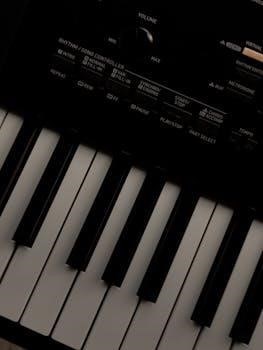Elements of Music
The core building blocks of music are varied and essential for composition and enjoyment․ These elements are often categorized as rhythm, melody, harmony, timbre, texture, dynamics, form, pitch, tempo, and expression․ Understanding them allows for a deeper appreciation of musical art․
Music, a universal language, is constructed from fundamental elements that interact to create diverse and expressive soundscapes․ These elements, including rhythm, melody, harmony, timbre, texture, dynamics, and form, are the core components that composers and musicians manipulate to shape musical pieces․ Understanding these building blocks allows for a deeper appreciation of the art form․ Rhythm, for instance, governs the duration of notes and the overall pulse of a piece, while melody defines the memorable tune or musical line․ Harmony adds depth and complexity through the combination of multiple notes simultaneously․ Timbre, often referred to as the color of music, distinguishes sounds based on their unique characteristics․ The way different layers of sound interact is termed texture, while dynamics refer to the loudness or softness of the music․ Finally, form dictates the overall structure and organization of a composition․ Each element plays a vital role in shaping the final musical experience, working in concert to evoke emotions and communicate ideas through sound․
Rhythm⁚ Duration and Tempo

Rhythm, a fundamental element of music, encompasses both the duration of individual sounds and silences, and the overall pace, or tempo, of a piece․ Duration refers to how long a note or rest is held, contributing to the rhythmic pattern․ Short notes and long notes can alternate to create various rhythmic figures, making the pulse or beat of the music․ Tempo, on the other hand, is the speed at which the beat is delivered․ It can be described using Italian terms such as largo (slow), adagio (slow and graceful), allegro (fast), and presto (very fast)․ A fast tempo can create a sense of excitement or urgency, while a slow tempo might evoke feelings of calmness or sadness․ The combination of duration and tempo shapes the rhythmic feel of a musical piece and is crucial for creating its overall character․ These aspects of rhythm work together to propel the music forward․
Melody⁚ Range, Shape, and Movement
Melody, often considered the most memorable aspect of a musical piece, is essentially a succession of single tones or pitches that are perceived as a unified whole․ It is characterized by its range, shape, and movement․ Range refers to the distance between the lowest and highest notes in the melody, which can be narrow or wide․ The shape of a melody is the contour it creates as it moves through different pitches, it can be described as stepwise or angular․ Melodic movement can be conjunct or disjunct․ Conjunct movement is stepwise, with notes moving by small intervals, making the melody smooth and flowing․ Disjunct movement, on the other hand, involves larger intervals, leading to a more angular, leaping quality․ These aspects of melody contribute to its unique character, making it a very expressive element in music․ A well-crafted melody draws the listener in and guides them through the musical journey․
Harmony⁚ Chords and Triads
Harmony is the element of music that involves the simultaneous sounding of two or more notes, creating a vertical dimension to the musical texture․ It’s fundamental to the structure and emotional content of a musical piece․ Chords are a core component of harmony and consist of three or more different notes that sound together․ Among the various types of chords, triads are the simplest and most commonly used․ A triad is a three-note chord constructed by stacking intervals of thirds․ These can be major, minor, diminished, or augmented, each with its own distinct sound․ Harmony not only provides a sense of depth and richness but also generates movement and progression within a piece of music․ The progression of chords, known as chord progressions, creates a sense of tension and release, guiding the listener’s ear and creating specific musical effects․ Understanding harmony involves learning about chord structures and their functional relationships within a tonal context․

Timbre⁚ The Color of Music
Timbre, often described as the “color” of music, refers to the unique quality of a sound that distinguishes it from others, even when they have the same pitch and loudness; It’s what makes a piano sound different from a violin, or a male voice different from a female voice․ Timbre is determined by the complex combination of overtones, or harmonics, present in a sound․ Each instrument or voice produces its own unique set of these overtones, creating its characteristic sonic fingerprint․ The manipulation of timbre is a powerful tool for composers and musicians, allowing them to create a wide range of expressive effects․ Different timbres can evoke various emotions and associations․ For example, the warm timbre of a cello may evoke feelings of melancholy, while the bright timbre of a trumpet might convey excitement․ Understanding timbre enhances our appreciation of music and allows us to distinguish the subtle nuances within a composition․ It is an essential element that contributes to the richness and complexity of musical experience, working alongside melody and harmony․
Texture⁚ Layers of Sound
Musical texture refers to how different melodic, rhythmic, and harmonic materials are combined in a composition, creating layers of sound․ It’s the fabric of the music, describing the relationship between various musical lines․ Monophonic texture features a single melodic line without accompaniment, like a solo vocalist singing a simple tune․ Homophonic texture involves a primary melody supported by chords or harmonic accompaniment, such as a singer with guitar backing․ Polyphonic texture consists of multiple independent melodic lines interwoven together, creating a complex interplay of sounds, common in fugues and canons․ Texture can vary within a piece, moving between different densities and complexities․ A composition might shift from a thin monophonic texture to a rich, polyphonic texture to create contrast․ The density of a texture is described as thin or thick, depending on the number of layers․ Understanding musical texture reveals the structure of a piece and the relationship between its elements․ It is a crucial aspect of musical composition and interpretation․
Dynamics⁚ Loudness and Softness
Dynamics in music refer to the variations in loudness or softness within a piece․ They are a fundamental element of musical expression, contributing significantly to the emotional impact and overall character of the music․ Dynamic markings indicate the relative volume of musical passages, ranging from very soft to very loud․ Common dynamic terms include pianissimo (very soft), piano (soft), mezzo piano (moderately soft), mezzo forte (moderately loud), forte (loud), and fortissimo (very loud)․ Crescendos and decrescendos, indicated by symbols or words, denote gradual increases or decreases in volume, respectively․ These dynamic changes can create dramatic effects or provide subtle nuances in the music․ Composers use dynamics to shape phrases, emphasize certain musical ideas, and create contrast․ Dynamic variation is essential to a captivating musical performance․ A piece could start softly and gradually grow in intensity, creating a sense of drama․ The range of dynamic contrasts enhances the expressiveness of the music, allowing for a more engaging and meaningful experience for the listener․ Understanding dynamics is crucial for both performers and listeners․
Form⁚ Structure and Organization

Musical form refers to the overall structure and organization of a piece of music․ It’s the blueprint that determines how the different sections of a composition are arranged and related to one another․ Form provides a framework that helps listeners understand the narrative or development of the music․ Common musical forms include binary (AB), ternary (ABA), rondo (ABACA), sonata form, theme and variations, and strophic form․ Each form has its own unique characteristics and patterns of repetition and contrast․ Understanding form is essential for both composers and listeners alike․ Composers use form as a tool to create coherence and interest, while listeners benefit from recognizing the structure as it unfolds․ Form can be identified by analyzing the relationships between musical phrases, sections, and themes․ The use of repetition, variation, and contrast contributes to the overall shape of the music․ Different forms offer various ways to create dramatic tension and resolution, and thus contribute to the emotional impact of the music․ Form provides a sense of order and purpose in music, giving it a logical and compelling structure․ The organizational framework of a piece plays a crucial role in how we perceive and engage with music․

Pitch⁚ Highness or Lowness
Pitch refers to the perceived highness or lowness of a musical sound․ It is determined by the frequency of sound waves; the faster the vibration, the higher the pitch․ In music, pitch is organized into scales, melodies, and harmonies․ Specific pitches are given names, such as A, B, C, D, E, F, and G, and these are often modified by sharps and flats․ The concept of pitch is fundamental to music, allowing for the creation of distinct musical intervals and relationships between notes․ The human ear can perceive a wide range of pitches, but musical compositions typically utilize a smaller selection within that range․ The relationship between pitches creates musical tension and resolution, which helps to shape the emotional impact of music․ Composers manipulate pitch to create melodic lines, harmonic structures, and expressive nuances․ Pitch also plays a key role in the development of themes and motifs within a musical work․ Understanding pitch is crucial to comprehending the structure and meaning of music․ Variations in pitch contribute to the overall character and mood of a piece, and help differentiate between various musical styles․ The use of high and low pitches contributes to the dynamic range of musical expression․
Tempo⁚ Speed of Music
Tempo, in music, dictates the overall pace or speed at which a piece is performed․ It is a fundamental element that influences the mood, energy, and character of a composition․ Tempo is typically measured in beats per minute (BPM), with higher BPM indicating a faster tempo and lower BPM indicating a slower tempo․ Composers often use Italian terms to specify tempo, such as “allegro” for fast, “adagio” for slow, and “moderato” for moderate․ Changes in tempo can create dramatic shifts in the music’s intensity․ A gradual increase in tempo is referred to as accelerando, while a gradual decrease is called ritardando․ The choice of tempo is a crucial part of the composer’s creative expression and significantly affects how the music is perceived․ Variations in tempo can add interest and excitement, and it is a powerful tool for engaging the listener․ The tempo chosen also impacts other musical elements, such as rhythm and dynamics, as they must align to create an effective and cohesive musical experience․ Certain genres of music often adhere to specific tempo ranges, contributing to their characteristic style․ Understanding and manipulating tempo allows musicians to evoke a range of emotions and communicate intentions․ The correct tempo is essential for interpreting a piece accurately and conveying its intended meaning․
Expression⁚ Emotional Content
Expression in music refers to the emotional content and feeling conveyed through a piece․ It is the aspect of music that allows it to evoke specific sentiments, moods, and reactions in the listener․ It’s not just about the notes themselves, but also how they are played and interpreted․ Dynamics, tempo, phrasing, and articulation all contribute to the overall expression of a musical work․ A skilled performer can use these elements to bring out the emotional nuances embedded in the score․ Musical expression can range from joy and excitement to sadness and melancholy․ It’s the way in which the musical elements are combined and manipulated that creates the emotional impact․ A piece played with a legato touch will sound smoother, conveying a different emotion than the same piece played staccato․ Composers often use specific harmonies and melodic patterns to communicate particular emotions․ The performer’s interpretation is crucial in bringing the composer’s intent to life․ Expression in music involves conveying not only the basic emotions, but also the subtle shades and complexities of human feeling․ Ultimately, expression is the element that allows music to resonate with the listener on a deeper level, making it a powerful form of communication․
Musical Instruments
Musical instruments are essential tools for creating and performing music․ They are broadly categorized into families based on how they produce sound, including stringed, wind, and percussion instruments․ Stringed instruments, like violins and guitars, create sound through vibrating strings․ Wind instruments, such as flutes and trumpets, use air to produce sound․ Percussion instruments, like drums and cymbals, create sound when struck or shaken․ Within each family, there are further subdivisions based on specific characteristics and construction․ For example, wind instruments can be further divided into woodwinds and brass instruments․ The timbre or tonal color of an instrument significantly impacts the overall sound of a musical composition․ Different instruments bring unique qualities to a piece, adding depth and texture․ The choice of instruments is a crucial aspect of orchestration and arrangement, affecting the character and mood of the music․ Instruments have evolved greatly over time, and various cultures have developed their own unique traditions․ From ancient drums to modern synthesizers, musical instruments enable musicians to express themselves and share their creativity․ The study of instruments is vital for any musician as it enables them to understand the capabilities and possibilities of different sound sources․ The skill with which an instrument is played greatly influences the musical outcome․
Style⁚ Genre and Characteristics
Musical style encompasses the unique characteristics that define a particular genre or tradition․ Genre refers to categories of music, such as classical, jazz, rock, pop, and folk, each with its own distinct history and conventions․ These styles are not just labels, but rather represent collections of shared musical elements and cultural contexts․ The characteristics of a style include specific rhythmic patterns, melodic structures, harmonic progressions, timbral preferences, and formal arrangements․ For instance, classical music often features complex harmonies, intricate forms, and a wide dynamic range, while rock music may emphasize strong rhythmic grooves, electric instruments, and a simpler structure․ Each genre carries with it a set of cultural associations, reflecting the time period, geographic location, and social groups that created it․ The study of music styles is essential for understanding musical history and how different cultures express themselves through sound․ Composers and performers often blend various styles to create new and innovative forms of music․ The identification of the genre of the music helps listeners to understand the musical intent and to appreciate its nuances․ These musical styles shape the way music is composed, performed, and received․ Understanding style is crucial for interpreting the meaning and impact of a musical piece․
